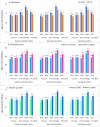Adolescent sexual and reproductive health in sub-Saharan Africa: who is left behind?
- PMID: 32133182
- PMCID: PMC7042602
- DOI: 10.1136/bmjgh-2019-002231
Adolescent sexual and reproductive health in sub-Saharan Africa: who is left behind?
Abstract
Adolescent sexual and reproductive health (ASRH) continues to be a major public health challenge in sub-Saharan Africa where child marriage, adolescent childbearing, HIV transmission and low coverage of modern contraceptives are common in many countries. The evidence is still limited on inequalities in ASRH by gender, education, urban-rural residence and household wealth for many critical areas of sexual initiation, fertility, marriage, HIV, condom use and use of modern contraceptives for family planning. We conducted a review of published literature, a synthesis of national representative Demographic and Health Surveys data for 33 countries in sub-Saharan Africa, and analyses of recent trends of 10 countries with surveys in around 2004, 2010 and 2015. Our analysis demonstrates major inequalities and uneven progress in many key ASRH indicators within sub-Saharan Africa. Gender gaps are large with little evidence of change in gaps in age at sexual debut and first marriage, resulting in adolescent girls remaining particularly vulnerable to poor sexual health outcomes. There are also major and persistent inequalities in ASRH indicators by education, urban-rural residence and economic status of the household which need to be addressed to make progress towards the goal of equity as part of the sustainable development goals and universal health coverage. These persistent inequalities suggest the need for multisectoral approaches, which address the structural issues underlying poor ASRH, such as education, poverty, gender-based violence and lack of economic opportunity.
Keywords: health policy; public Health.
© Author(s) (or their employer(s)) 2020. Re-use permitted under CC BY-NC. No commercial re-use. See rights and permissions. Published by BMJ.
Conflict of interest statement
Competing interests: None declared.
Figures



References
-
- United Nations,, Department of Economics and Social Affairs . World population prospects, 2019. Available: https://population.un.org/wpp/Download/Standard/Interpolated/ [Accessed 8 Jul 2019].
-
- UNICEF Child marriage: latest trends and future prospects, 2018. Available: https://data.unicef.org/resources/child-marriage-latest-trends-and-futur... [Accessed 19 Oct 2019].
Publication types
MeSH terms
LinkOut - more resources
Full Text Sources
Medical
